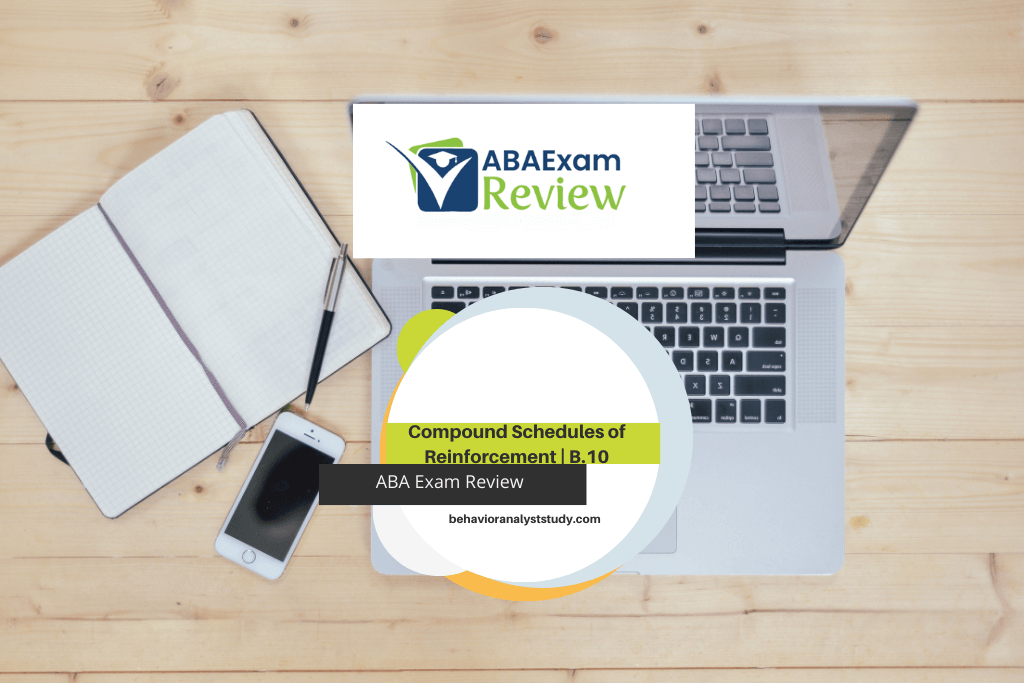Compound schedules of reinforcement combine two or more basic schedules—like fixed ratio (FR), variable ratio (VR), fixed interval (FI), or variable interval (VI)—to create more complex patterns of reinforcement delivery. These compound schedules allow practitioners to control when and how reinforcement is provided across different behaviors, settings, or sequences.
Before diving into the complexities of concurrent, multiple, mixed, and chained schedules, it’s crucial to have a solid grasp of basic schedules. Once you’ve mastered these, understanding compound schedules becomes a matter of logical combinations with added rules.
Watch the Full Lesson
Here’s the full video breakdown of this topic for visual and auditory learning:
What Are Compound Schedules?
A compound schedule of reinforcement uses two or more basic schedules to dictate when reinforcement is available. These basic schedules (FR, VR, FI, VI) can be combined in different ways to:
- Offer choices between schedules.
- Alternate between schedules across time.
- Link schedules together in a sequence.
In the 6th edition BCBA® Task List, the focus is narrowed to just four compound schedules:
- Concurrent schedules
- Multiple schedules
- Mixed schedules
- Chained schedules
Concurrent Schedules of Reinforcement
Concurrent schedules involve two or more reinforcement schedules operating at the same time, each linked to a different behavior. The learner has access to all schedules simultaneously and can choose how to allocate their behavior.
Defining Features
- Simultaneous availability of two or more schedules.
- Each schedule controls a different behavior or response option.
- The rate, quality, and immediacy of reinforcement influences choice.
Example in ABA
A student can either:
- Complete math problems on an FR 2 schedule to earn tokens, or
- Read silently on an FI 3-minute schedule to earn praise.
Both activities are available at the same time, and the learner can switch between them.
Matching Law
Behavior allocation in concurrent schedules often follows the matching law, meaning responses are distributed in proportion to the rate of reinforcement for each option. In the example above, the student might spend more time on math because tokens are delivered more frequently, but still engages in reading occasionally for praise.
BCBA® Exam Tip
Look for scenarios where a choice between two schedules is possible at the same time—those are concurrent schedules.
Multiple Schedules of Reinforcement
Multiple schedules alternate between two or more reinforcement schedules, but each schedule is signaled by a distinct discriminative stimulus (SD) so the learner knows which schedule is currently in effect.
Defining Features
- Two or more basic schedules alternate over time.
- Each schedule is paired with a unique SD.
- The SD signals the availability and type of reinforcement.
Example in ABA
- Green card visible: FR 3 schedule for independent work.
- Blue card visible: VI 5-minute schedule for group discussion.
When the green card is up, the learner knows FR 3 is active; when the blue card is up, VI 5 minutes is active.
Why It’s Useful
Multiple schedules allow practitioners to signal changes in reinforcement conditions. This can help shape behavior according to environmental cues and reduce learner frustration.
BCBA® Exam Tip
If the schedule alternates and there is a clear signal for each, it’s a multiple schedule.
Mixed Schedules of Reinforcement
Mixed schedules are essentially the same as multiple schedules, but there is no SD to signal which schedule is currently in effect.
Defining Features
- Alternating two or more schedules.
- There are no external cues to signal which is active.
- The learner cannot predict when the schedule will change until reinforcement is delivered.
Example in ABA
Sometimes a learner receives a break after three completed tasks (FR 3), sometimes after four minutes of work (FI 4 min). The change between schedules is random, and no visual or auditory signal tells the learner which is in place.
Why It’s Challenging for Learners
Without clear cues, the learner must continue responding without knowing when reinforcement will occur, which can increase persistence but may also increase frustration if schedules are too thin.
BCBA® Exam Tip
If the schedule alternates but no signal indicates the change, it’s a mixed schedule.
Chained Schedules of Reinforcement
Chained schedules require completing a series of components, each associated with a distinct SD, in a specific order before reinforcement is delivered.
Defining Features
- Two or more basic schedules are presented in a fixed sequence.
- Each component has its SD.
- Completion of one component signals the next.
- Reinforcement is delivered only after the entire chain is completed.
Example in ABA
- First, complete a sprint for 30 seconds (FR 1).
- Then, walk for 90 seconds (FI 90 sec).
- Only after completing both steps is water provided as reinforcement.
Why It’s Useful
Chained schedules are ideal for teaching complex sequences—like multi-step tasks or routines—where each step leads toward a terminal reinforcer.
BCBA® Exam Tip
If tasks occur in sequence and each has its SD, it’s a chained schedule.

Comparing the Four Schedules
| Schedule | Alternating or Simultaneous? | SD Present? | Sequence Required? | Example |
| Concurrent | Simultaneous | Yes (implied by task) | No | Two tasks with different schedules available at once |
| Multiple | Alternating | Yes | No | Green card = FR 3, Blue card = VI 5 min |
| Mixed | Alternating | No | No | FR 3 and FI 4 alternate without signals |
| Chained | Sequential | Yes | Yes | Complete FR, then VI, then reinforcement |
Practical ABA Applications
- Concurrent schedules are common in natural environments where multiple behaviors compete for reinforcement.
- Multiple schedules are helpful when teaching discrimination between contexts or conditions.
- Mixed schedules can build persistence when cues are not always available in the real world.
- Chained schedules are essential for task analysis and teaching life skills that require sequences.
Key Takeaways
- Concurrent = choice between simultaneous schedules.
- Multiple = alternating schedules with clear SDs.
- Mixed = alternating schedules without SDs.
- Chained = sequential schedules with SDs and required order.
Practical Strategies for Implementing Compound Schedules in ABA
Mastery of concurrent, multiple, mixed, and chained schedules is only useful if you can apply them effectively in real programming. While each schedule type serves a different purpose, all require thoughtful planning, clear data collection, and flexibility based on learner performance.
Start with Clear Definitions and Visual Cues
When introducing multiple or chained schedules, clear discriminative stimuli (SDs) help the learner know what’s expected. Use consistent visual cues, colors, or symbols so the learner can easily discriminate between different reinforcement conditions. Over time, fade these cues to promote generalization.
Teach Choice-Making in Concurrent Schedules
Concurrent schedules are a perfect way to build functional choice-making skills. Present options with different reinforcement rates or types and track how the learner allocates their behavior. This not only informs programming but also builds autonomy—learners begin to identify which activities bring them the best outcomes.
Fade Predictability When Appropriate
In real-world environments, reinforcement availability is not always clearly signaled. Gradually moving from multiple to mixed schedules can prepare learners for less predictable contexts. This transition should be data-driven to ensure persistence and reduce frustration.
Use Chained Schedules for Complex Life Skills
For tasks like cooking, laundry, or vocational routines, chained schedules break the process into clear, teachable steps. Each completed step acts as a conditioned reinforcer by signaling the next step. This approach keeps learners engaged through to the terminal reinforcer while building real independence.
Monitor Response Patterns Closely
Different schedules produce different patterns of responding—steady, scalloped, or high burst rates. Tracking these patterns helps you adjust the schedule for optimal engagement and prevents behaviors from dropping off when reinforcement conditions change.
FAQs
How can I remember the difference between multiple and mixed schedules?
Think of “multiple” as having multiple cues—each schedule comes with its SD. “Mixed” has no cues; the learner is in the dark about which schedule is active until reinforcement happens. This distinction is one of the most common BCBA® exam traps for this topic.
Are concurrent schedules always based on different behaviors?
Usually, yes, but they can also involve the same behavior maintained by different schedules in different contexts. For instance, typing emails on an FR schedule and chatting with coworkers on a VI schedule can both be available simultaneously. The key is that the schedules operate at the same time.
Why are chained schedules important for skill teaching?
They break down complex behaviors into manageable parts, each reinforced by progress toward the end goal. For example, in vocational training, a learner may complete several linked tasks, each prompting the next, until a final product is completed and reinforcement is delivered. This builds fluency and independence in multi-step activities.
When would I use a mixed schedule in ABA therapy?
Mixed schedules are useful when you want to promote persistence or prepare a learner for environments where cues for reinforcement availability aren’t obvious. They can be a bridge between highly signaled learning conditions and more natural, unpredictable environments.
Also Read: Mastering Simple Schedules of Reinforcement: BCBA® Exam Study Guide

